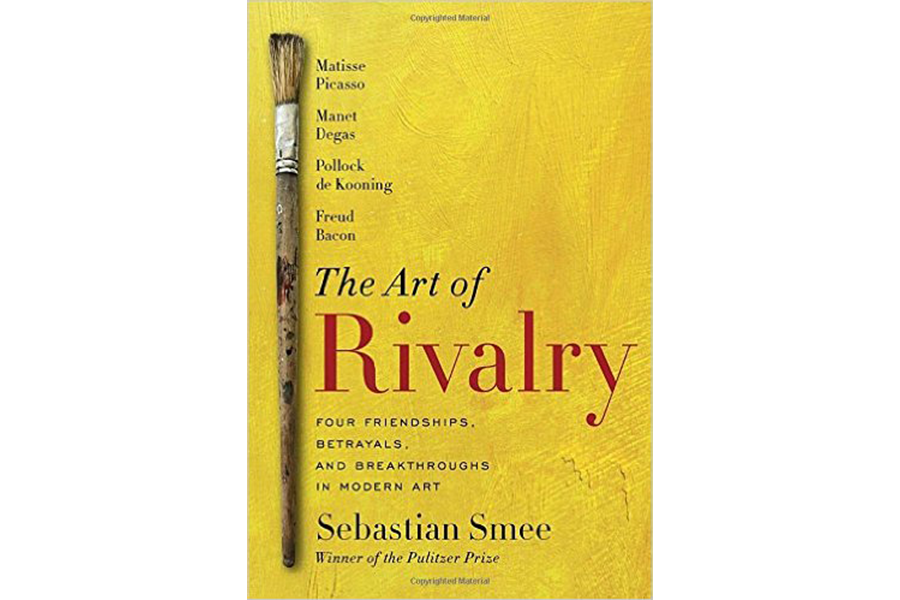'The Art of Rivalry' considers painters as competitors
Loading...
Art may be a deeply competitive business, but it’s not supposed to be a contact sport. Still, as in so many fields of endeavor, fury can eclipse the unwritten rulebook.
Just ask the bold Impressionist painter Édouard Manet, who took a knife to a portrait by his friend Edgar Degas and sliced through the paint strokes depicting a woman’s face and body. And not just any woman. She’s Manet’s wife; the double portrait depicts the two of them.
In response, Degas sent a Manet still-life to back to the master with a note for the ages: “Monsieur, I am returning your Plums.”
Or consider a pair of mid-century stars. Jackson Pollock once convinced Willem de Kooning to punch him in the mouth, drawing blood, and then refused to fight back: “What? Me hit an artist?”
These attacks are more than intriguing side shows in the grand gossipy guignol of fine art, argues Boston Globe art critic Sebastian Smee writes in his perceptive new book. He believes these and other examples of “breakups and betrayal” showcase the crucial painter-vs.-painter passions that spurred eight brilliant modern artists toward their greatest work.
In each case, the Pulitzer Prize-winning Smee argues, rivalry liberated the artists enmeshed in these ultra-complicated friendships. “Cracks of possibility opened up, A new way not only of working but of facing the world was revealed. The direction of one’s life was changed,” he writes in The Art of Rivalry: Four Friendships, Betrayals and Breakthroughs in Modern Art.
To put it another way, these intense rivalries mattered, and they mattered intensely.
Smee offers a quartet of dual mini-biographies: Manet and Degas, Pollack and de Kooning, Pablo Picasso and Henri Matisse, and Lucian Freud and Francis Bacon. (Smee acknowledges that they’re all men but argues that he wants to explore rivalries among similar artists. Most other significant relationships between modern artists in the era from 1860 to 1950, he contends, are complicated by romance between men and women.)
That’s not to say that these rivalries were free of their own romantic entanglements. Only a flow chart would do justice to all the intimate links between these men, the women in their lives, and even each other. Perhaps only Sigmund Freud, grandfather of Lucian Freud, could offer insight into pairings like De Kooning’s rapid pursuit of the Pollock’s girlfriend after his death.
Smee combs through these connections and many others in search of insight into his book’s thesis about the vast push-and-pull influence of these rivalries.
Matisse and Picasso, he writes, were almost “engaged in a series of subtle martial arts maneuvers transposed to the aesthetic realm.” De Kooning, meanwhile, envied the older Pollock’s talent and “cut loose,” seeking a sense of “being in his paintings, unaware of what he was doing.”
While they have some healthy competition, Manet and Degas – the two Impressionists – may be the most confounding duo in the entire book.
They were said to be friends, the charming dandy Manet and the more detached and awkward Degas, a kind of acolyte whose technique challenged his master’s.
No one knows why Manet was so infuriated at the Degas portrait of him and his wife. The painting doesn’t offer much in the way of hints, as Smee discovers when he travels all the way to a remote Japanese museum to look at it.
In the painting, a dressed-up Manet reclines awkwardly on a couch, looking like he’s waiting, with a dose of impatience, or is simply lost in thought. His wife Suzanne, in a blouse and dress, looks in the opposite direction, a possible sign of marital disconnect. But something is deeply wrong.
She once sat at a piano in the portrait, perhaps boring her husband with her performance. But Manet came along and slashed the painting. Almost a third of it is now gone forever, cut out and replaced with blank canvas. Missing in action for all time: a chunk of Mrs. Manet, including the front of her face, and the entire piano.
Maybe Manet just couldn’t stand the portrayal of his wife. But Smee is skeptical: “You don’t take a knife to a painting quite so easily. There must, surely, have been more to it.”
Whatever the case, poor Mrs. Manet is forever incomplete. She’s essentially excised from a moment in art, a co-star turned bit player. The spotlight has instead turned to two men: The one in the foreground and the one behind the canvas. What happened here?
We’ll never know for sure what they thought of each other. Nor will we fully understand the other rivalries profiled here. But it’s clear that Smee is onto something important. His book may bring us as close as we’ll ever get to understanding the connections between these bristly bonds and brilliance.








